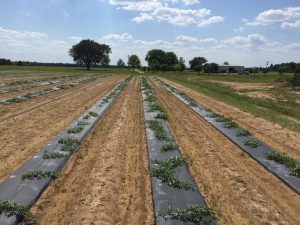Some production systems, particularly vegetables, utilize wide row spacing (anywhere from 4 to 8 foot wide). In these systems it is of economic and environmental importance to fertilize the crop root zones evenly, and not fertilize the row middles, where nutrients will go to waste or could even become a pollutant. The linear bed foot method (LBF) is utilized in order to help growers with mulched beds apply the correct amount of nutrients based on soil test recommendations.

Plastic mulch-bed systems utilize the linear bed foot method. (PC:Blake Thaxton)
Different row spacing are used by growers, so the LBF system standardizes the rate regardless of the chosen row spacing. The LBF system uses the fertilizer recommendation, usually expressed in a pounds to the acre (lbs of NPK/Acre) format, and the “typical row spacing” for the crop being grown. The “typical row spacing” can be found in Table 1 below, and will also be supplied by UF/IFAS extension soil testing reports.
Using this information, you can calculate that in an acre planted with a six foot row spacing (center to center), 100 linear bed foot will fit 72.6 times.
- 43,560 square feet in an Acre/6 ft row spacing = 7,260 LBF
- 7,260 LBF/100 = 72.6 (100 ft of row)
On the same acre a grower could have 100 linear bed foot fit 108.9 times with a four foot row spacing.
- 43,560 square feet in an Acre/4 ft row spacing = 10,890 LBF
- 10,890 LBF/100 = 108.9 (100 ft of row)
Although, there will be more total fertilizer applied to the field with the 4 foot row spacing, each 100 foot of row will receive the same amount of fertilizer regardless of the row spacing.
Once the grower has a fertilizer recommendation based on soil testing, that information can be used to acquire the amount of fertilizer to apply per 100 linear bed foot (or 100 feet of row). The fertilizer recommendation will be expressed in pounds/acre. This number can be converted to the lbs/100 linear bed foot by using Table 2 below. Using this conversion table will allow growers to apply the same amount of fertilizer per plant, regardless of the chosen row spacing. This is accomplished by expressing the amount of fertilizer to be applied in 100 linear bed foot increments.
Read more about the Linear Bed Foot system and additional examples of how it is used in the following UF/IFAS publication:
Calculating Recommended Fertilizer Rates for Vegetables Grown in Raised-Bed, Mulched Cultural Systems
- Battling Scab in Panhandle Pecan Trees - September 22, 2017
- Where to Start with Marketing Fresh Produce? - April 28, 2017
- Using the Linear Bed Foot System for Vegetable Fertilization - August 26, 2016


